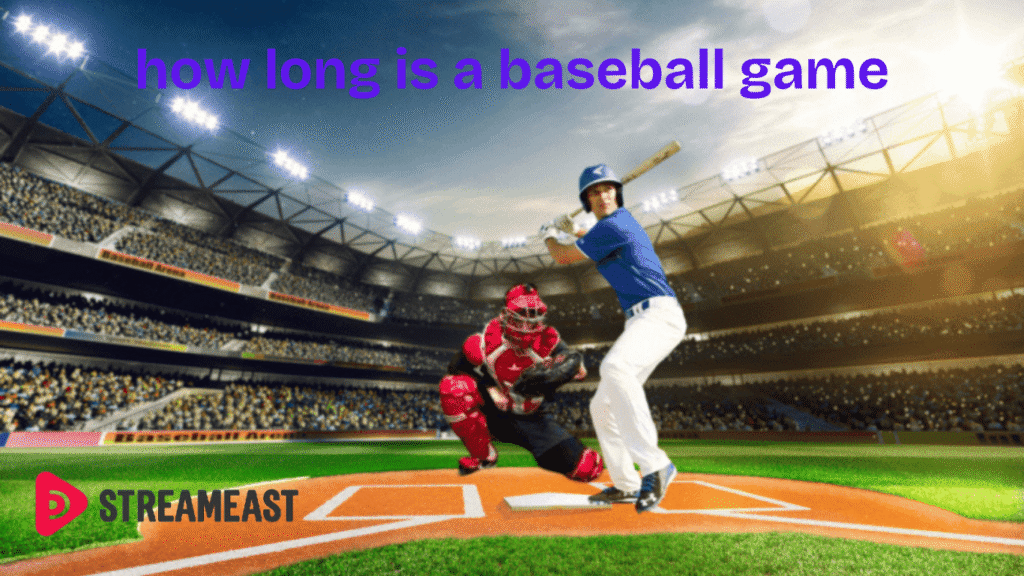For anyone planning to attend their first baseball game or curious about America’s pastime, one of the most common questions is: how long is a baseball game? The answer isn’t as straightforward as you might expect. While the average Major League Baseball game now runs approximately 3 hours and 6 minutes, the actual baseball game duration can vary significantly based on numerous factors. Understanding these variables helps fans better plan their baseball experience and appreciate the unique rhythm of this beloved sport.
This comprehensive guide will explore everything you need to know about baseball game length, from MLB contests to youth leagues, and explain why some games finish in under two hours while others stretch well beyond four hours.
Average Baseball Game Length Across Different Levels
MLB Regular Season Games
Major League Baseball games currently average 3 hours and 6 minutes during the regular season, according to 2024 data. This represents a significant improvement from recent years, thanks to new pace-of-play rules implemented by MLB. The league has made substantial efforts to reduce the average baseball game time while maintaining the sport’s strategic depth.
Minor League Games
Minor league contests typically range from 2 hours and 45 minutes to 3 hours. These games often move more quickly than MLB games due to fewer commercial breaks, less strategic maneuvering, and generally less experienced players who work at a faster pace.
High School and College Baseball
High school and college games usually last between 2 to 2.5 hours. These contests benefit from shorter commercial breaks, seven-inning games in some cases, and mercy rules that can end games early when one team builds a commanding lead.
Youth Baseball
Youth baseball games are significantly shorter, typically lasting 1.5 to 2 hours depending on the age group. Younger leagues often implement time limits, reduced inning counts, and modified rules designed to keep games moving and maintain player engagement.
Factors That Affect Game Duration
Innings Structure
The standard baseball game consists of nine innings, with each team getting three outs per half-inning. However, this basic structure can extend the MLB game length considerably when games go into extra innings. Unlike other sports with definitive time clocks, baseball games continue until one team has more runs after a complete inning.
Extra innings scenarios occur when games are tied after nine innings, and these can theoretically continue indefinitely. Some of the longest games in baseball history have lasted well over five hours due to extended extra-inning play.
Amateur leagues often implement mercy rules to prevent excessively long games. These rules end contests early when one team builds an insurmountable lead, helping maintain reasonable game durations.
Pace of Play Elements
Several factors directly impact how long does baseball take:
Pitcher Delivery Time: Some pitchers work quickly between pitches, while others take extended time to analyze situations and decide on their approach. This variation significantly affects the overall rhythm and duration of games.
Time Between Batters: The interval between at-bats, including warm-up pitches and batter preparation, adds considerable time to each game. MLB has implemented specific rules to limit these delays.
Commercial Breaks: Television broadcasts include commercial breaks between innings and during pitching changes, extending the baseball game duration for viewers and attendees. Radio broadcasts and live attendance experience fewer interruptions.
Mound Visits and Coaching Conferences: Strategic discussions between coaches, pitchers, and catchers can slow game pace. MLB has limited the number of mound visits per game to address this issue.
Game Situation Factors
The flow and circumstances of each contest significantly influence duration:
High-Scoring vs. Low-Scoring Games: Games with numerous runs typically last longer due to extended innings with multiple at-bats, base runners, and pitching changes. Conversely, pitcher’s duels with few base runners often conclude more quickly.
Pitching Changes: Teams that frequently substitute pitchers experience longer games due to warm-up time and strategic delays. Relief pitcher usage has increased dramatically in modern baseball, contributing to extended game times.
Replay Reviews and Challenges: Video review systems, while improving accuracy, add time to contests. Each challenge and review can extend games by several minutes.
Weather Delays: Rain delays, lightning warnings, and extreme weather conditions can significantly impact the total time spent at the ballpark, sometimes adding hours to the overall experience.
Historical Changes in Game Length
Baseball game duration has evolved considerably throughout the sport’s history. In the 1950s and 1960s, the average baseball game time was approximately 2.5 hours. Games moved at a brisker pace, with fewer pitching changes, shorter commercial breaks, and different strategic approaches.
During the 1980s and 1990s, the average duration increased to around 2 hours and 45 minutes. This gradual increase reflected changes in strategy, increased specialization of relief pitchers, and growing commercial interests in the sport.
The 2000s and 2010s saw baseball game duration grow to over 3 hours regularly. This expansion concerned many fans and league officials, as longer games potentially deterred casual viewers and created challenges for families attending games.
Recent rule changes have aimed to reverse this trend and speed up play while maintaining the strategic elements that make baseball compelling.
MLB’s Efforts to Shorten Games
2023 Rule Changes
Major League Baseball implemented several significant rule changes in 2023 to address concerns about MLB game length:
Pitch Clock Implementation: Pitchers now have 15 seconds to deliver a pitch with bases empty and 20 seconds with runners on base. This represents the most significant change to baseball’s traditional pace in decades.
Batter Timeout Restrictions: Batters are limited in their ability to call timeout and step out of the batter’s box, forcing them to stay engaged and ready to hit.
Pickoff Attempt Limits: Pitchers can attempt only two pickoff throws per at-bat, reducing the time spent on these often unsuccessful tactical moves.
Results and Impact
These rule changes have successfully reduced the average baseball game time by approximately 30 minutes compared to previous seasons. Fan reactions have been largely positive, with many appreciating the improved pace without losing the sport’s strategic depth.
Player reactions have been mixed but generally accepting, as they recognize the importance of appealing to modern audiences with shorter attention spans. The changes have made baseball more competitive with other major sports in terms of viewing time investment.
Different Levels and Variations
Doubleheaders
Doubleheader games, where teams play two contests in one day, feature seven-inning games instead of the traditional nine innings. This modification helps ensure both games can be completed in a reasonable timeframe while providing fans with extra baseball action.
Spring Training
Spring training games typically run shorter than regular season contests. These exhibitions focus on player evaluation and preparation rather than strategic maneuvering, leading to more streamlined gameplay and reduced baseball game duration.
Playoff Games
Playoff contests often extend beyond the average baseball game time due to heightened strategic play. Managers use their full roster more liberally, make frequent pitching changes, and employ more deliberate tactical approaches. The pressure and importance of these games naturally slow the pace.
World Series
World Series games historically average slightly longer than regular season contests, reflecting the increased commercial breaks, ceremonial elements, and strategic intensity of baseball’s championship series.
Planning Your Baseball Experience
Understanding how long baseball takes helps fans plan their ballpark visits effectively. Most attendees should plan for approximately 3.5 to 4 hours at the stadium, including arrival, parking, concession visits, and departure time.
Stadium-Specific Considerations
Different ballparks have varying transportation options, parking situations, and crowd flow patterns that affect the total time investment. Urban stadiums with public transportation access often provide quicker entry and exit options compared to suburban venues relying primarily on automobile access.
Weekend vs. Weekday Differences
Weekend games, particularly Saturday and Sunday afternoon contests, often feature larger crowds and may experience longer concession lines and parking delays. Weekday games typically offer a more streamlined experience with shorter wait times.
Day vs. Night Games
Day games, especially during weekdays, often conclude more quickly due to smaller crowds and reduced commercial considerations. Night games, particularly those televised nationally, may include extended commercial breaks and ceremonial elements.
Conclusion
The question of how long is a baseball game doesn’t have a simple answer, as the baseball game duration varies significantly based on level of play, game situations, and external factors. Current MLB games average just over 3 hours, while youth games may finish in half that time.
For first-time attendees, planning for approximately 3.5 hours provides a comfortable buffer for the full baseball experience. The recent pace-of-play improvements have made games more viewer-friendly while preserving the sport’s strategic complexity.
The future outlook for game pace appears positive, with continued focus on maintaining reasonable durations without compromising the elements that make baseball America’s pastime. As the sport continues to evolve, finding the right balance between tradition and modern expectations remains an ongoing priority.
Frequently Asked Questions
What’s the shortest MLB game ever?
The shortest MLB game in modern history lasted just 51 minutes, played between the New York Giants and Philadelphia Phillies in 1919. In recent decades, the shortest games typically last around 1 hour and 45 minutes.
What’s the longest MLB game ever?
The longest MLB game by time lasted 8 hours and 6 minutes between the Chicago White Sox and Milwaukee Brewers in 1984. By innings, several games have extended to 26 innings, with the most recent occurring in 2019.
Do playoff games take longer?
Yes, playoff games typically run 15-30 minutes longer than regular season contests due to increased strategic maneuvering, more pitching changes, and additional commercial breaks during televised coverage.
How long are rain delays typically?
Rain delays vary significantly based on weather conditions. Brief delays may last 30-60 minutes, while severe weather systems can postpone games for several hours or force postponement to another day entirely.






